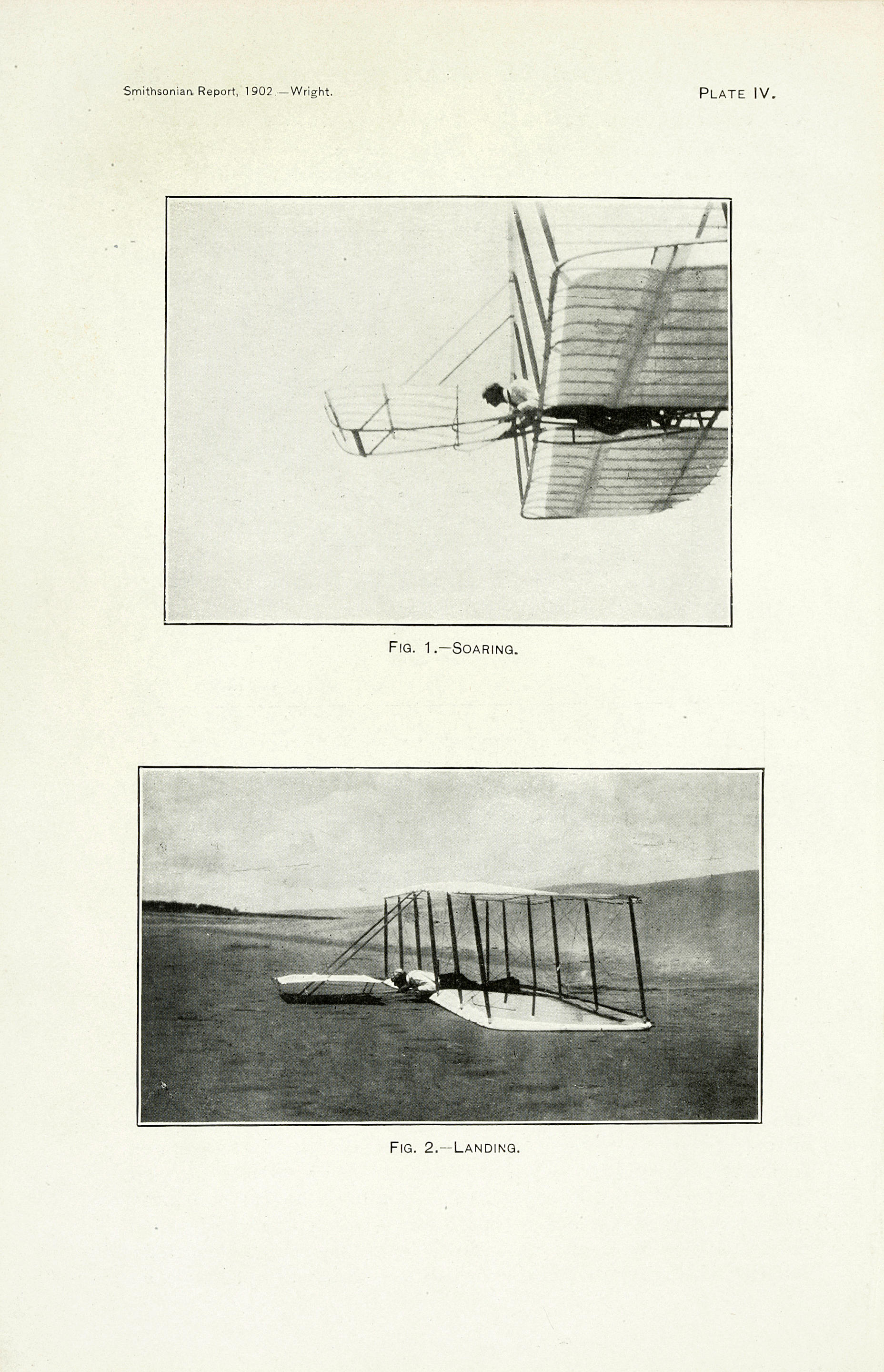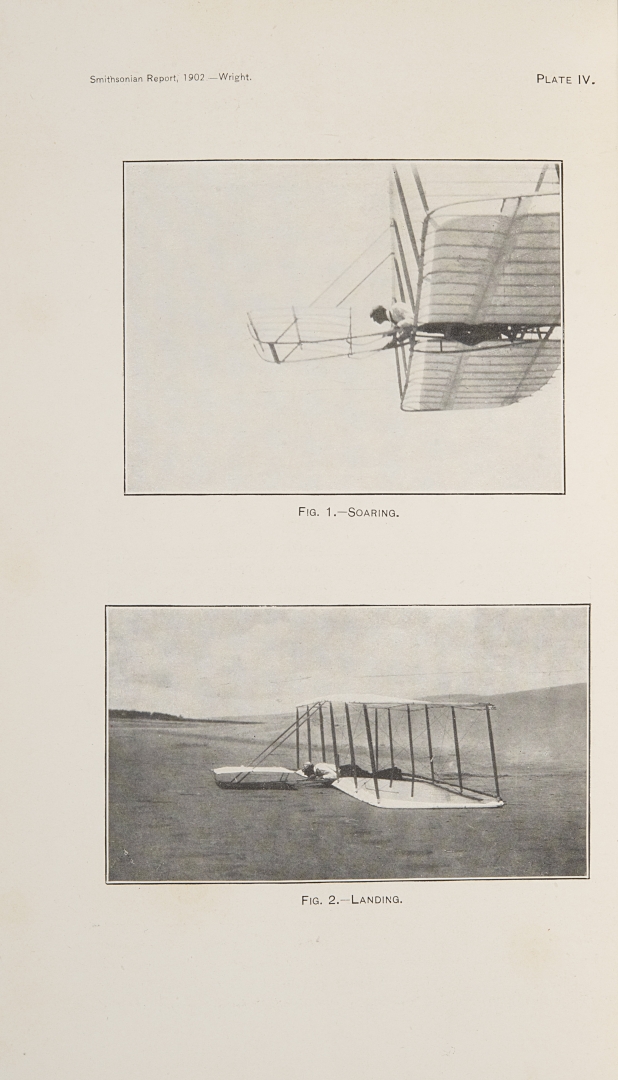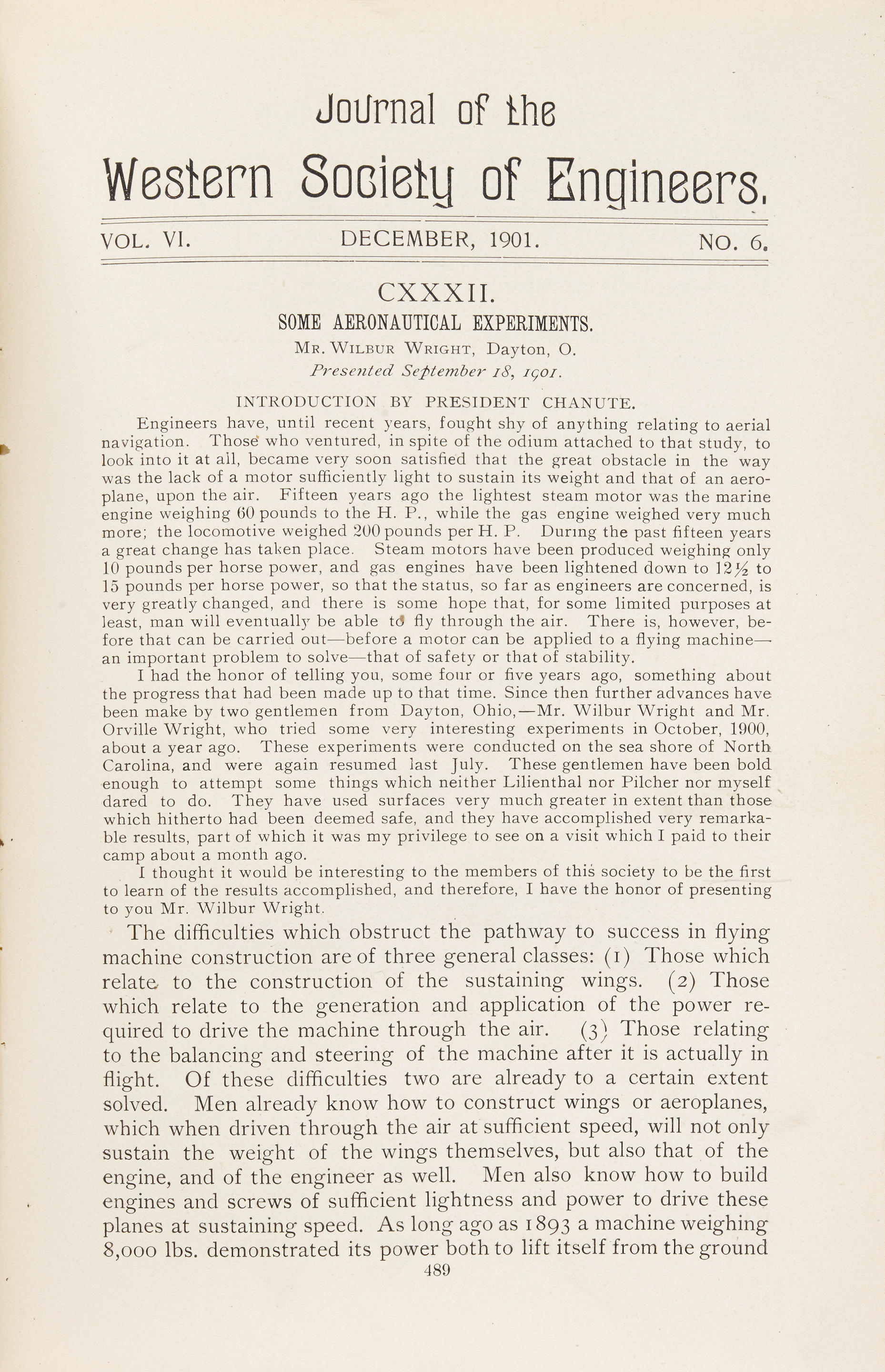WRIGHT, Wilbur (1867-1912). Some Aeronautical Experiments . Offprint from Journal of the Western Society of Engineers 6 (December, 1901). [Chicago, 1901]. 8 o (231 x 152 mm). Caption title; 10 halftones reproducing photographs and 2 line block illustrations in text. (Repair to first leaf cropping two words on verso). Original printed wrappers (recent cloth spine, small repaired tear to lower wrapper, some minor chipping); morocco-backed folding case. Provenance : Wilhelm Kress, Vienna (inkstamp on front wrapper); Vienna, Bibliothek des Oesterreichischen Flugtechnischen Vereines (inkstamps). FIRST EDITION, offprint issue, of the Wright brothers' first published report of their first trial flights with motorless gliders at Kitty Hawk, "the work that made their experiments famous" (Norman). The brothers Wilbur and Orville Wright, Indiana bicycle manufacturers, had grown interested in the possibilities of human flight following the death of the German aeronaut Otto Lilienthal in 1896. After three years of intensive study of the existing aeronautical literature, the brothers built their first flying machine, a biplane kite-glider with a 5-foot wingspread, modeled upon Octave Chanute's five-plane glider (see below), but incorporating wing-warps--Wilbur Wright's solution to the problem of lateral control. A year later they built their first full-sized glider, with a 17 foot span, and in the summer of 1900 a still larger glider, with a 22-foot wing-span. The present paper, which Wilbur read to the Western Society of Engineers on September 18, 1901, describes these progressive developments and the brothers' trial flights at the beach of Kitty Hawk, North Carolina in the summer of 1901, during which they achieved glides of up to 389 feet. "Their work was painstaking, thoroughly scientific, with a careful tabulation of data and critical examination of all conclusions. The glides indicated that a vertical steering rudder was essential... and that calculations based on existing data were in error" (DAB). In order to perfect, therefore, their machine's performance, the Wrights returned to Dayton to pursue their aerodynamic research. This important paper was written and read to the Society at the urging of its president Octave Chanute, a French-born civil engineer whose passion for aeronautics made him "an international clearing house for information on aviation" ( The Wright Brothers: Heirs of Prometheus , Smithsonian Institution 1978, p. 15), and whose own carefully tabulated gliding experiments in 1896 and 1897 paved the way for the Wrights' later successes. "The Wrights never failed to acknowledge the help they received from Chanute and considered him one of the greatest pioneers in the engineering problems of flight" (DAB). "Chanute was so certain of this paper's significance that he ordered 300 copies of the offprint, 150 of which he sent to colleagues in the United States and abroad, and 150 of which he sent to the Wright brothers for their use" (Norman). The present copy is almost certainly one of the 150 reserved by Chanute for his own use (see following lot). RARE. Dibner Heralds of Science 185; Norman 2266.
WRIGHT, Wilbur (1867-1912). Some Aeronautical Experiments . Offprint from Journal of the Western Society of Engineers 6 (December, 1901). [Chicago, 1901]. 8 o (231 x 152 mm). Caption title; 10 halftones reproducing photographs and 2 line block illustrations in text. (Repair to first leaf cropping two words on verso). Original printed wrappers (recent cloth spine, small repaired tear to lower wrapper, some minor chipping); morocco-backed folding case. Provenance : Wilhelm Kress, Vienna (inkstamp on front wrapper); Vienna, Bibliothek des Oesterreichischen Flugtechnischen Vereines (inkstamps). FIRST EDITION, offprint issue, of the Wright brothers' first published report of their first trial flights with motorless gliders at Kitty Hawk, "the work that made their experiments famous" (Norman). The brothers Wilbur and Orville Wright, Indiana bicycle manufacturers, had grown interested in the possibilities of human flight following the death of the German aeronaut Otto Lilienthal in 1896. After three years of intensive study of the existing aeronautical literature, the brothers built their first flying machine, a biplane kite-glider with a 5-foot wingspread, modeled upon Octave Chanute's five-plane glider (see below), but incorporating wing-warps--Wilbur Wright's solution to the problem of lateral control. A year later they built their first full-sized glider, with a 17 foot span, and in the summer of 1900 a still larger glider, with a 22-foot wing-span. The present paper, which Wilbur read to the Western Society of Engineers on September 18, 1901, describes these progressive developments and the brothers' trial flights at the beach of Kitty Hawk, North Carolina in the summer of 1901, during which they achieved glides of up to 389 feet. "Their work was painstaking, thoroughly scientific, with a careful tabulation of data and critical examination of all conclusions. The glides indicated that a vertical steering rudder was essential... and that calculations based on existing data were in error" (DAB). In order to perfect, therefore, their machine's performance, the Wrights returned to Dayton to pursue their aerodynamic research. This important paper was written and read to the Society at the urging of its president Octave Chanute, a French-born civil engineer whose passion for aeronautics made him "an international clearing house for information on aviation" ( The Wright Brothers: Heirs of Prometheus , Smithsonian Institution 1978, p. 15), and whose own carefully tabulated gliding experiments in 1896 and 1897 paved the way for the Wrights' later successes. "The Wrights never failed to acknowledge the help they received from Chanute and considered him one of the greatest pioneers in the engineering problems of flight" (DAB). "Chanute was so certain of this paper's significance that he ordered 300 copies of the offprint, 150 of which he sent to colleagues in the United States and abroad, and 150 of which he sent to the Wright brothers for their use" (Norman). The present copy is almost certainly one of the 150 reserved by Chanute for his own use (see following lot). RARE. Dibner Heralds of Science 185; Norman 2266.







.jpg)



.jpg?height=400)



Testen Sie LotSearch und seine Premium-Features 7 Tage - ohne Kosten!
Lassen Sie sich automatisch über neue Objekte in kommenden Auktionen benachrichtigen.
Suchauftrag anlegen